- Study on the Effect of Tween80 on the Properties of PVA/SCFs Composites
*Shanghai Key Laboratory of Smart Manufacturing and Robotics, Shanghai University, Shanghai 200444, China
**National Demonstration Center for Experimental Engineering Training Education, Shanghai University, Shanghai 200444, China- PVA/SCFs 복합재료 물성에 대한 Tween80의 영향 연구
Reproduction, stored in a retrieval system, or transmitted in any form of any part of this publication is permitted only by written permission from the Polymer Society of Korea.
The properties of polyvinyl alcohol (PVA)/short carbon fibers (SCFs) electroactive shape memory composites after the addition of Tween80 were studied. The results showed that the addition of Tween80 caused a decrease in the electrical conductivity of the composites, and the conductivity of the composites decreased gradually with the increase of the Tween80 content. The addition of Tween80 significantly improved the deposition of SCFs in the matrix, which had a certain effect on the homogeneity of the composites. When the addition of Tween80 was 4%, it had the best tensile strength. The composite still showed good shape recovery properties under conductive conditions, while the shape fixity ratio has decreased. In addition, a smart gripper which could realize grasping action under electric stimulation was designed. The above results indicated that PVA/SCFs composites with appropriate Tween80 content could provide greater possibility for the potential application in the field of soft grippers.
Electroactive shape memory composites were prepared by compounding polyvinyl alcohol (PVA)/short carbon fibers (SCFs) with Tween80. The appropriate addition of Tween80 significantly improved the deposition effect of SCFs in PVA matrix and improved the tensile strength of the composites. In addition, an intelligent grip that can achieve grasping action under electrical stimulation has been designed.
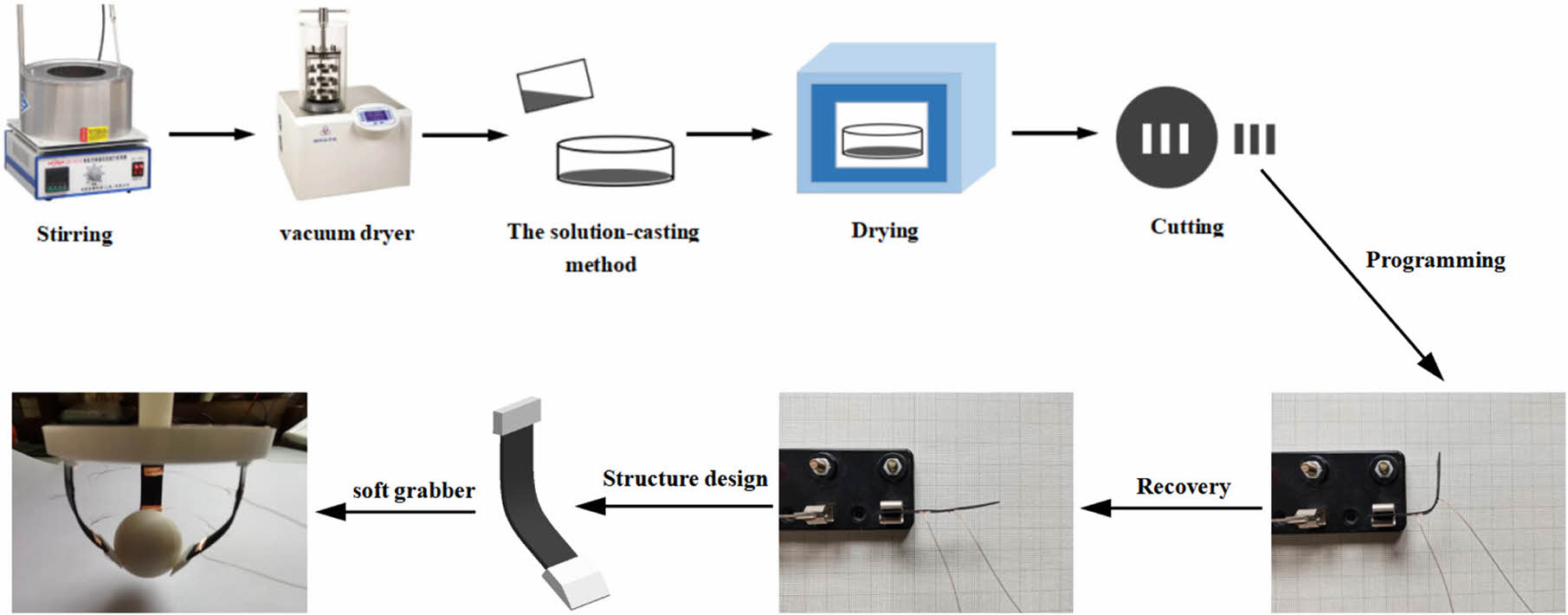
Keywords: composites, tensile properties, shape memory properties, self-folding, soft gripper.
We acknowledge the School of Material Science & Engineering, Shanghai University, for providing assistance regarding the provision of the laboratory equipment.
The authors declare that there is no conflict of interest.
Shape memory polymers (SMPs) are intelligent materials that can respond to external stimuli and achieve autonomous shape recovery.1 The stimulation methods of SMP materials include temperature, electric field, magnetic field, light, ph, etc.2-6 SMPs have many excellent properties, such as low price, strong deformation ability, adjustable glass transition temperature and so on, and have shown great application value in intelligence structure, aerospace, biomedical, and many other fields.7-9 However, SMPs have some disadvantages, such as low deformation stiffness and low shape recovery stress.10 But SMPs can be compounded with other functional materials to make shape memory polymer composites, which can make up for the shortcomings of SMPs while giving it the ability to achieve intelligent deformation under various external stimuli.11 Among many stimulation methods, electrical activation has become an important branch of research due to its advantages of remote actuation, adjustable actuation voltage, designable structure and fast response. Essentially, the electro-induced shape memory effect is an entropy phenomenon, and its mechanism is basically similar to that of the thermally-induced shape memory effect.12,13 SMPs are not electrically conductive, but it forms a continuous internal conductive network after being compounded with conductive fillers, making it have conductive characteristics.14 The characteristic of conductive shape memory polymer composites is to realize electrically driven deformation by using Joule thermal effect under the condition of electrical stimulation. Electrically driven shape memory polymer composites have shown great potential for applications in soft robots, self-folding structures, actuator and so on.15-17
Various conductive fillers are usually embedded in non-conductive polymer systems to obtain electroactive shape memory properties. Most conductive fillers are carbon-based materials, such as graphene, carbon nanotubes (CNTs), carbon black (CB) and short carbon fibers (SCFs).18-22 Compared with other conductive fillers, SCFs are easier to form a continuous network in the matrix, and the composites have stronger conductivity. In the previous study, we introduced SCFs to reinforce PVA matrix composites. Compared with pure PVA, its mechanical properties and shape memory properties have been improved.23 However, after PVA was compounded with a certain amount of SCFs, it was found that SCFs in PVA had obvious uneven dispersion and deposition, which led to a decrease in the mechanical properties of the composite. The dispersion of SCFs in PVA would affect the uniformity of the composite, and the uniformity is an important factor affecting the property of the composite. The carbon nanofibers (CNFs) were preprocessed by chemical modification and physical treatment to achieve better dispersion quality in the solution.24 Guadagno et al.25 showed that high temperature heating could significantly reduce the permeability threshold and improved the conductivity by enhancing the stiffness and smoothness of the CNFs surface. However, this CNFs surface treatment reduced its mechanical properties. Nie et al.26 found that silanization of CNFs by APTES could effectively enhance the tensile strength of the composite, while its electrical conductivity was greatly reduced compared to the untreated ones. However, the effect of these treatments on the final electrical and mechanical properties of composites are not always positive. Tween80 as a dispersant, which can evenly disperse inorganic solid particles that are difficult to dissolve in liquid, and can prevent the sedimentation of particles. Kato et al.27 used Tween80 to stabilize the dispersion of single-walled carbon nanotubes (SWCNTs) and observed that the dispersion of SWCNTs/Tween80 aqueous solution was very stable for at least 3 weeks.
In this study, Tween80 was introduced into the PVA-based electroactive SMP. The properties of PVA/SCFs/Tween80 composites were studied by mechanical and electrical conductivity measurement. Finally, their electrical induced shape memory property was studied. In application, a smart grabber composed of three self-folding structures was prepared, which could successfully grab a ball with a mass of 14.5 g. The addition of Tween80 with appropriate content has improved the mechanical properties of the composite and made it have greater application potential in the field of soft grippers.
Materials. Short carbon fibers (SCFs) were purchased from Easy Composites Ltd. and used as conductive fillers. Polyvinyl alcohol (PVA) purchased from Sinopharm Chemical Reagent Co., Ltd with a degree of polymerization about 1700 was used for the preparation of composites (polymer matrix material). Tween80 purchased from Sinopharm Chemical Reagent Co., Ltd. and was used as a dispersant.
Preparation of PVA/SCFs/Tween80 Composites. PVA/SCFs/Tween80 composites were prepared by solution-casting method. Dissolved the PVA in deionized water at 95 ℃ and stirred with a magnetic stirrer for 2 hours until a clear solution was obtained. The required amount of SCFs and Tween80 were mixed and dispersed in water for ultrasonic treatment for 2 h. Then, the SCFs/Tween80/water dispersion was added to the PVA solution and stirred for 6 hours until PVA/SCFs/Tween80 achieved uniform dispersion.
The uniform dispersion of PVA/SCFs/Tween80 was put into a vacuum dryer to remove bubbles. Finally, the uniform dispersion of PVA/SCFs/Tween80 was poured into a glass petri dish then dried it in an oven at 60 ℃ for 6 hours. After the water was fully evaporated, the required composite films were obtained. The preparation process of PVA/SCFs/Tween80 composites is illustrated in Figure 1. In the paper, different feed compositions were used to prepare these composites. We use TX to express the composites containing the content of X% Tween80 in Table 1.
Methods. The dispersion state of PVA/SCFs/Tween80 composites with different Tween80 content were observed by optical microscope (Eclipse Ti-U, Nikon Instruments Inc.). The interfacial structure was observed by scanning electron microscopy (SEM, SHU-SU1510) after gold coating. SEM images were obtained by applying an accelerating voltage of 15 kV. For the mechanical properties of PVA/SCFs/Tween80 composites, the tensile test of the composites was carried out using the electronic universal material testing machine (wdwe100) according to ASTM D638 standard. The composites were cut into strips of 10 mm wide and 40 mm long with a razor blade. Three samples were tested for each composite. The resistances of the samples were measured with a universal meter VC890 (Shenzhen, China). Similarly, three samples of each composite were measured for resistance.
Shape Memory Behaviors. The shape memory behaviors of PVA/SCFs/Tween80 composite samples were studied by bending test under the condition of electrical activation. The first step was to constrain the PVA/SCFs/Tween80 composite sample to bend into an "L" shape when heated above its Tg. The bending angle of the sample was recorded as θmax. The second step was to stop heating until the sample cooled to room temperature and maintained the "L" shape under constraint for a period of time. The third step was to remove the constraint and fixed the "L" shape. The bending Angle was recorded as θf. The fourth step was to heat the sample above Tg and restored the original shape through the restoring force generated by the shape memory polymer. The final recovery angle and recovery time were recorded as θt and t, respectively. The shape fixity ratio Rf and the shape recovery ratio Rr could be calculated as following relations:

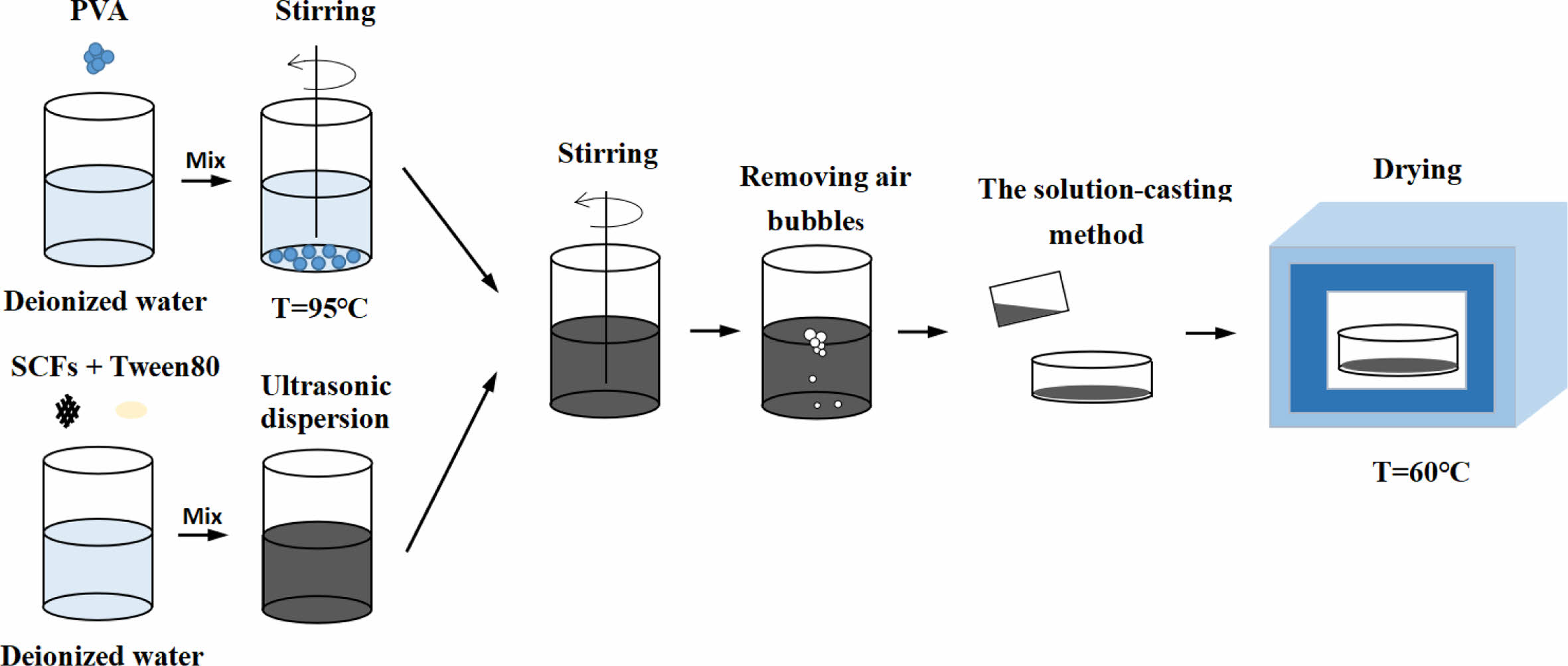
|
Figure 1 Schematic illustration of the PVA/SCFs/Tween80 composites fabrication. |
|
Table 1 Composition Ratios of PVA/SCFs/Tween80 with Different Contents (unit: wt%) |
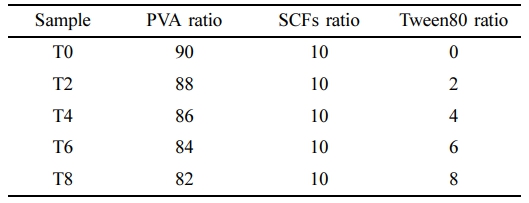
Longitudinal Section Morphology. The optical image of the longitudinal section of PVA/SCFs/Tween80 composites are shown in the Figure 2. From the optical image, it could be seen that SCFs with different content of Tween80 had different dispersion in the PVA matrix. Figure 2(a) clearly shows that SCFs in the PVA/SCFs sample without Tween80 has more deposition at the bottom. The optical image shown in Figure 2(b)-(e) shows the effect of different Tween80 content on the dispersion of SCFs in the PVA matrix. The added Tween80 would be adsorbed on the surface of SCFs, so that the SCFs were coated with a layer of polyelectrolyte, which acted as an electrostatic steric hindrance to achieve dispersion. It could be seen that the addition of Tween80 improves the deposition of SCFs in the matrix to a certain extent. Moreover, the dispersion of SCFs in the matrix was improved with the increase of Tween80 content in a certain range.
Tensile Properties. Tensile tests were carried out to study the tensile properties of composite samples and the results are shown in Figure 3. The common yield phenomenon and uniform elongation were observed in all samples. The results demonstrate that T4 sample has the highest tensile strength and highest Young’s modulus, 45.911 and 396.65 MPa respectively. Compared with T0 sample, the two indicators were enhanced by 48% and 76% respectively. The uniform dispersion of SCFs in PVA avoided the stress concentration caused by agglomeration, made the stress uniformly distributed and facilitated the transfer of stress, thus improving the mechanical properties of the composite. With the increase of Tween80 content, the Young’s modulus and tensile strength of the sample increased first and then decreased. There were two possible reasons for the decrease of tensile strength and Young’s modulus of T6 and T8 samples. The first reason was that excessive Tween80 would not help the dispersion of the composite and reduced the content of PVA relatively. The second reason was that the excess Tween80 would precipitate a small amount of SCFs on the upper surface of the film during the drying process, and caused obvious uneven thickness of the film after the composite was dried. This finding suggests that the appropriate amount of Tween80 in the PVA/SCFs composite can improve the uniformity and mechanical properties of the composite.
Electrical Properties. As shown in the Figure 4(a), the relationship between the distance and resistance of five samples with conductive network were determined. The length of the sample was 40 mm. The resistance of the sample was measured every 5 mm and repeated five times. The average of these five values was the valid data. It could be found that the resistance of the sample increased linearly with the increase of distance. With the increase of Tween80 content, the resistance value of the sample decreased gradually. Four-point probe (FPP) was used to detect the electrical conductivity of the sample.28 With the increase of Tween80 content, the electrical conductivity of PVA/SCFs/Tween80 decreased gradually. There was a clear downward trend when the added Tween80 content was 0-6%. The conductivity of T6 sample decreased by 4.5 times compared to T0 sample. when the Tween80 content continued to increase, the downward trend of electrical conductivity slowed significantly. The source of electrical conductivity was the formation of SCFs conductive path in PVA matrix. Adding proper amount of Tween80 helped the longitudinal dispersion of SCFs in the PVA matrix, resulting in a decline in electrical conductivity.
The relationship between surface temperature and applied voltage of T0, T2, and T4 samples are shown in Figure 5. The surface temperature of composite films was measured with a digital thermocouple (VC890, China) at 5, 7, and 9 V voltages. Over time, the surface temperature continued to rise due to the joule heat generated by the electric current. Obviously, the lower the resistance, the more joule heat generated at the same voltage. At 9 V voltage, the T0, T2, and T4 samples all reached the temperature of Tg (52.6 ℃) before 30 s, which satisfied the requirement of realizing the electroactive shape memory effect on the PVA/SCFs/Tween80 composites.23 However, under the voltage of 7 V, the T2 sample needed to be energized for more than 75 s to reach Tg, while the T4 sample failed to reach Tg because of its high resistance and the temperature did not rise when the heat generation and heat dissipation were balanced. On the other hand, higher voltages caused surface temperatures to rise faster. In summary, voltage and electrical conductivity were the key factors affecting shape memory effect.
To further understand the relationship between electrical properties and structures, the morphology of PVA/SCFs/Tween80 composites was studied by scanning electron microscopy, as shown in Figure 6. It revealed the microstructure of samples with different contents of Tween80, whose SCFs particles were uniformly distributed in the PVA matrix and showed the conductive networks on the bottom surface of the composites. It is obvious that with the increase of the Tween80 content, the shape of SCFs gradually became blurred and the conductive network began to disappear in Figure 6(a)-(d). The addition of Tween80 caused SCFs to be evenly dispersed throughout the longitudinal section, resulting in a decrease in SCFs deposited on the bottom surface. All these factors led to the decline of electrical performance.
Shape Memory Properties. Electroactive shape memory property is an important property of composites in application field. Figure 7 shows the shape memory process of T4 sample at 9 V voltage. It was found that when heated for the first time, the sample would bend spontaneously at a small angle. The cause of this phenomenon could be attributed to the release of internal stress during film formation. Under the constraint, the sample was bent into an "L" shape when heated above its Tg. During the shape recovery process, the sample began to recover from to 10 s and spontaneously returned to its initial shape within 40 s.
As shown in Figure 8(a), the shape recovery ratio versus time curve of T0, T2 and T4 samples under 9 V voltage. It could be seen that the T0 sample only took 20 s from the temporary shape to the original shape, while the T4 sample took 40 s. Due to the electrical conductivity of T4 sample was the lowest, it took more time to reach Tg at the same voltage. With the increased of Tween80 content, it took more time to complete the shape memory recovery process. At the same time, PVA/SCFs/Tween80 composite maintained a high shape recovery ratio.
As shown in Figure 7(b), under the same voltage stimulation, Rf decreased with the increase of Tween80 content, while there was no significant change in Rr. The values of Rf were 97.9%, 96.7%, and 95.1% respectively. The value of Rr remained around 93.7%. PVA/SCFs/Tween80 composites could dissolve in boiling water which showed that the crosslink in the composites could be composed of hydrogen bond. When the Tween80 blended with PVA, the molecular interaction between Tween80 and PVA would affect the crystallization of PVA. The hydrogen bonding between the two materials reduced the crystallinity of PVA, resulting in a decrease in its shape fixity ratio.29,30
Application in Soft Gripper. Advances in soft robotics and materials science have made rapid progress in soft grabbers. End-effectors made of flexible and flexible parts can usually grip or manipulate more kinds of objects than rigid grippers.31 In this paper, appropriate Tween80 was added to PVA/SCFs composite to improve the Young’s modulus and correspondingly improve its stiffness. Based on the above analysis and research, the composites with Tween80 have better mechanical properties. Therefore, PVA/SCFs/Tween80 composite was used as a flexible actuator to design a soft grabber. As shown in the Figure 9(a)-(b), the soft grabber was composed of three self-folding structures, each structure was composed of three parts, which were flexible actuator, assembly part and rigid part at the end of the actuator. Matching parts and rigid parts were manufactured by 3D printing. Rigid parts could be replaced according to different kinds and shapes of objects grasped by the soft grabber, to expand the application range of the soft grabber.
The three self-folding units need to have the same electrical conductivity and shape memory characteristics to achieve simultaneous deformation. The three units were connected in parallel to ensure the same working voltage. As shown in Figure 9(c), three units were first programmed into a straight shape. After the power was turned on, the soft gripper would gradually realize the gripping action. The resistance of the three units was 86.5, 85.4, and 85.9 Ω respectively, and the resistance of the parallel circuit was 28.6 Ω. Activate the soft gripper with a voltage of 9 V. A printed ball with a diameter of 30 mm and a mass of 14.5 g was selected as the target. As shown in Figure 8(d), the soft gripper successfully completed the grab task within 30 seconds.
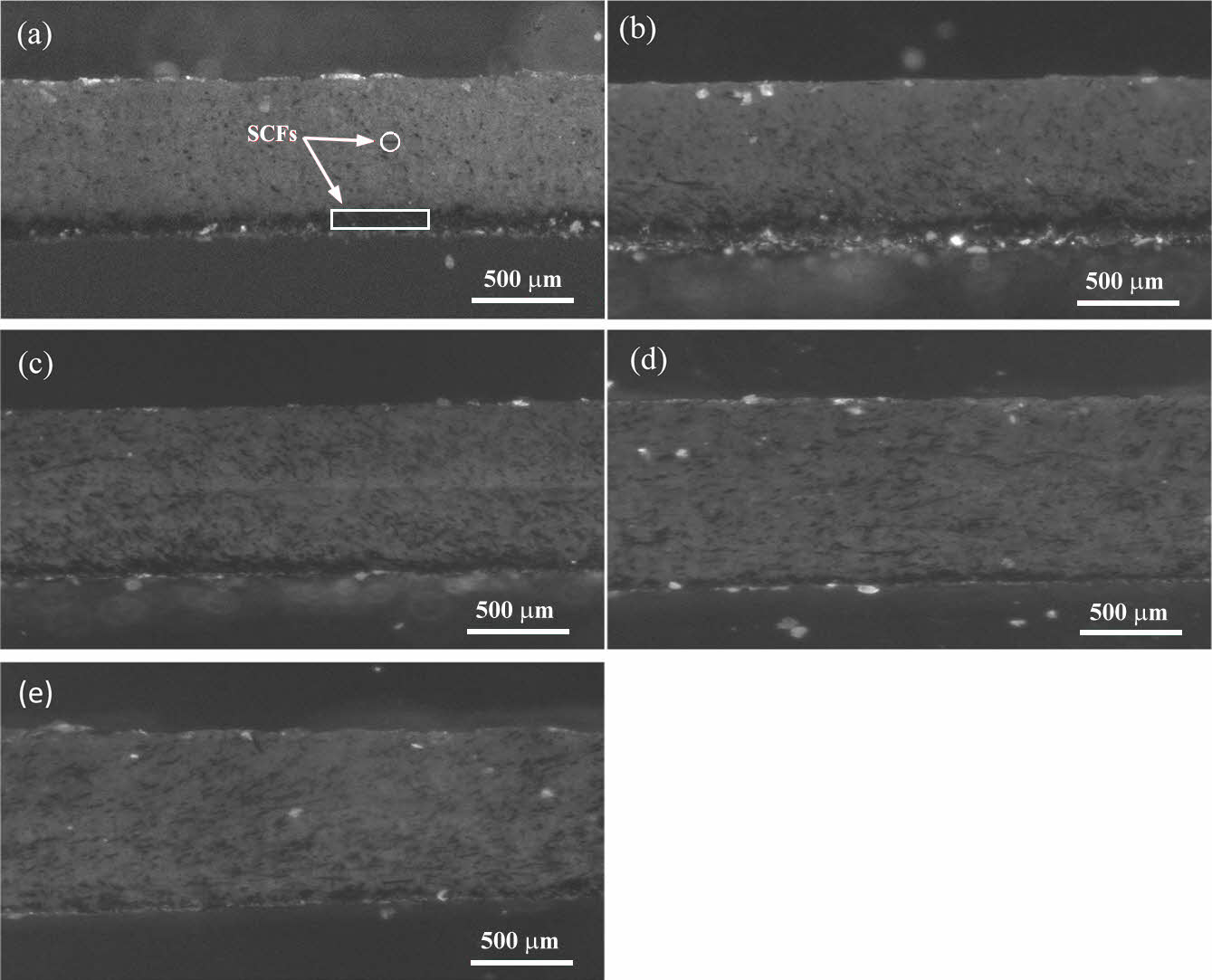
|
Figure 2 Optical images of the longitudinal section of samples at a magnification of 4×: (a) T0 sample; (b) T2 sample; (c) T4 sample; (d) T6 sample; (e) T8 sample. |
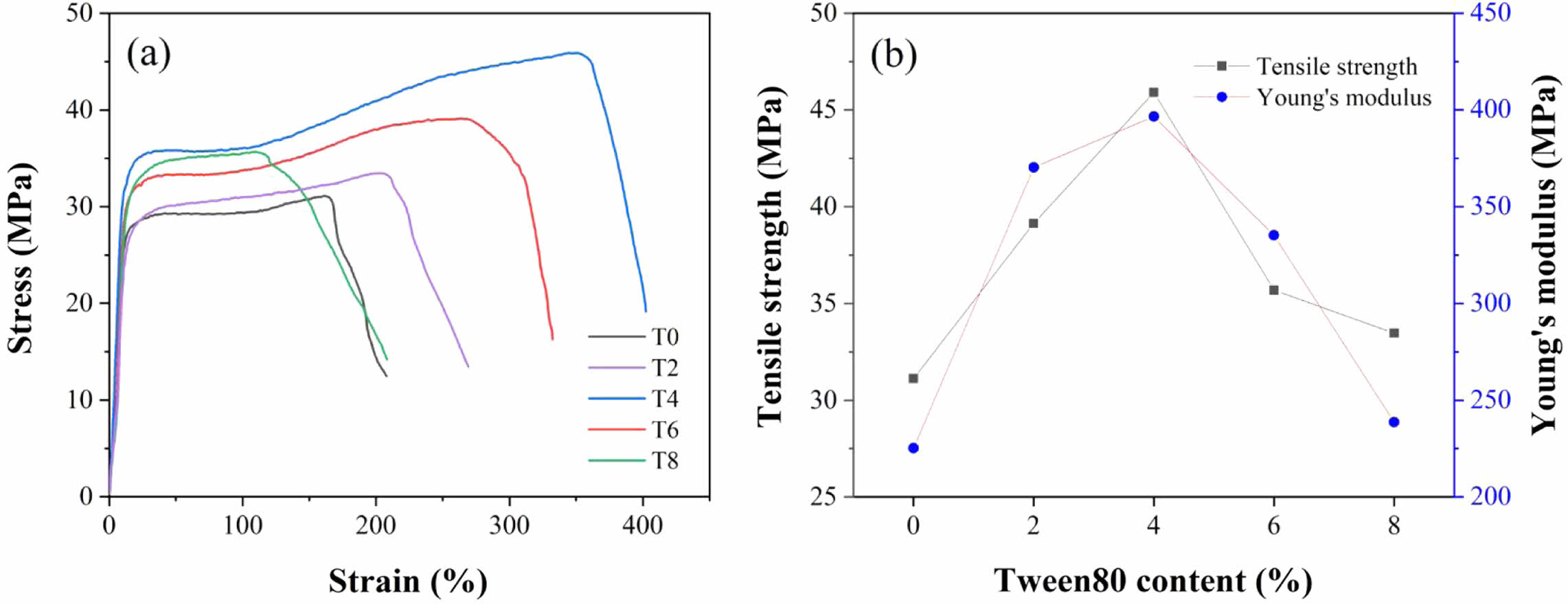
|
Figure 3 Tensile properties of PVA/SCFs/Tween80 composites with different Tween80 contents: (a) stress-strain curves of PVA/SCFs/ Tween80 composite films; (b) tensile strength, Young’s modulus of PVA/SCFs/Tween80 composites. |
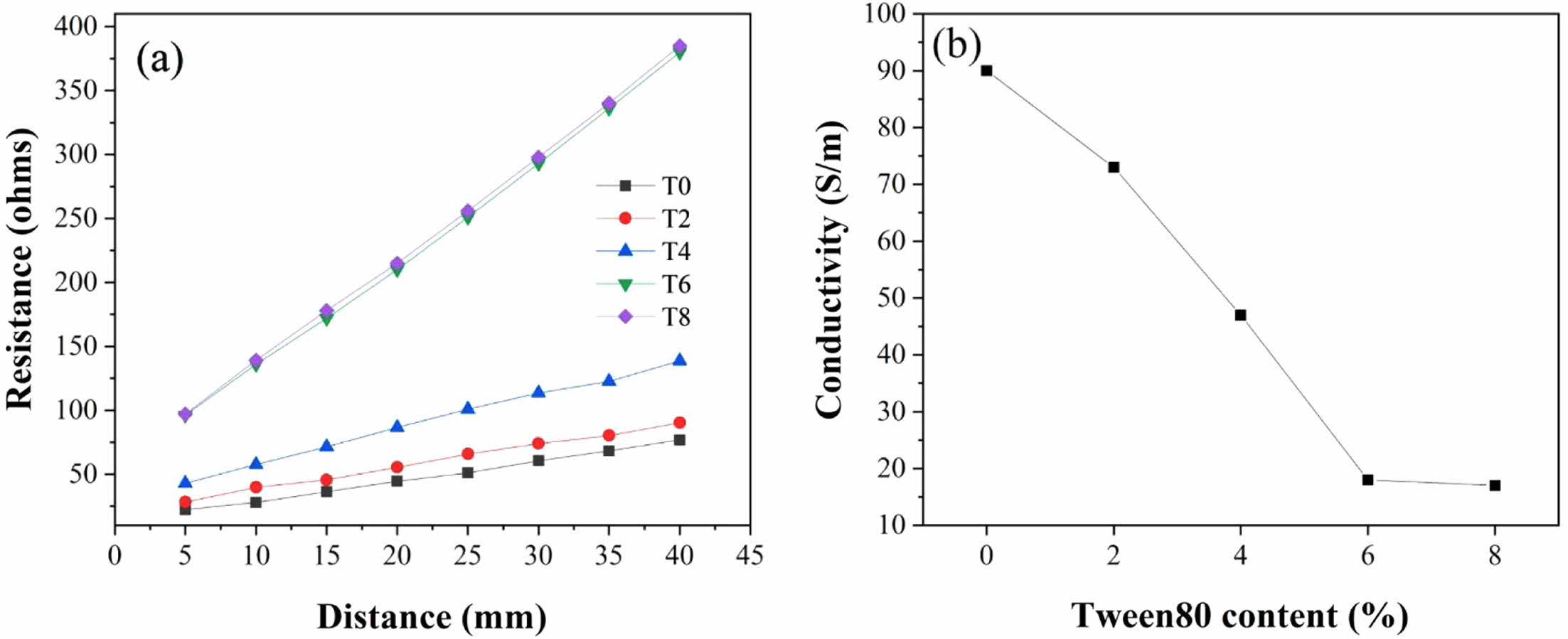
|
Figure 4 Electrical properties of PVA/SCFs/Tween80 composites with different Tween80 contents: (a) resistance curves; (b) electrical conductivity. |
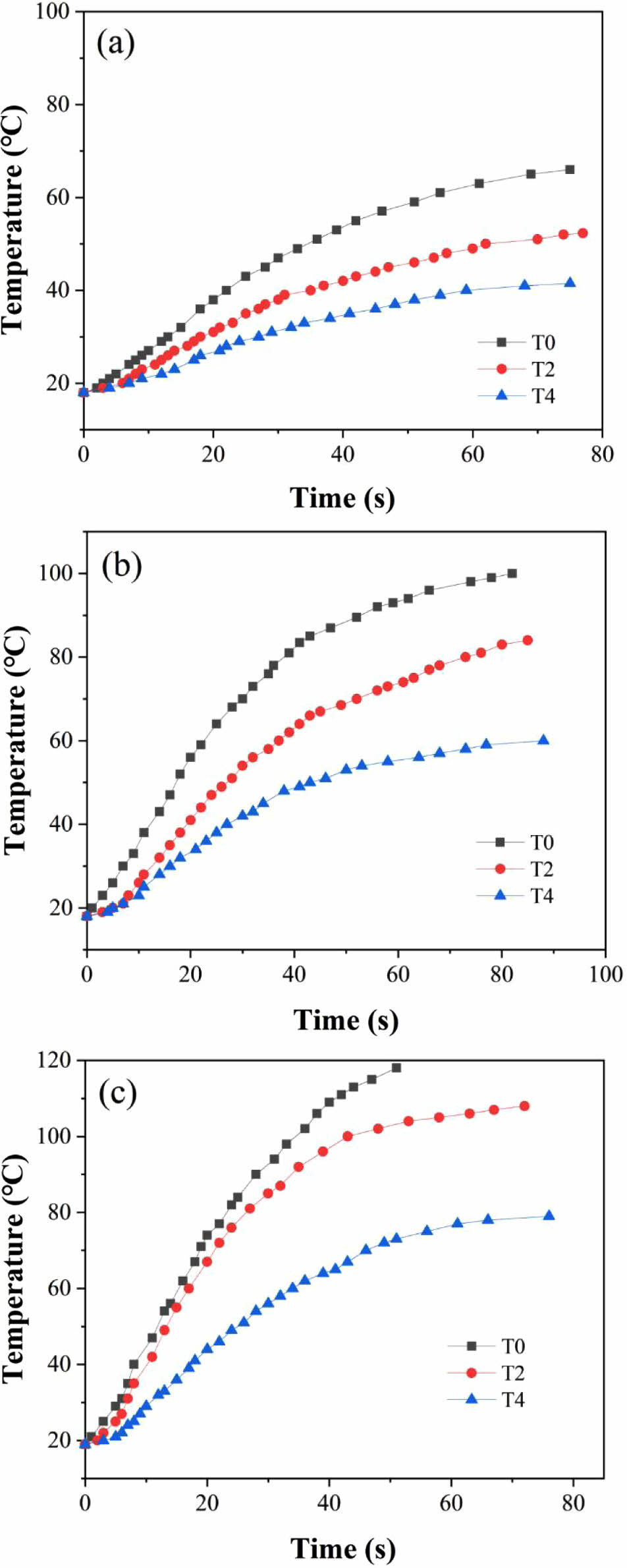
|
Figure 5 Content of Tween80 affects the heating rate of the sample at: (a) 5V; (b) 7V; (c) 9 V. |
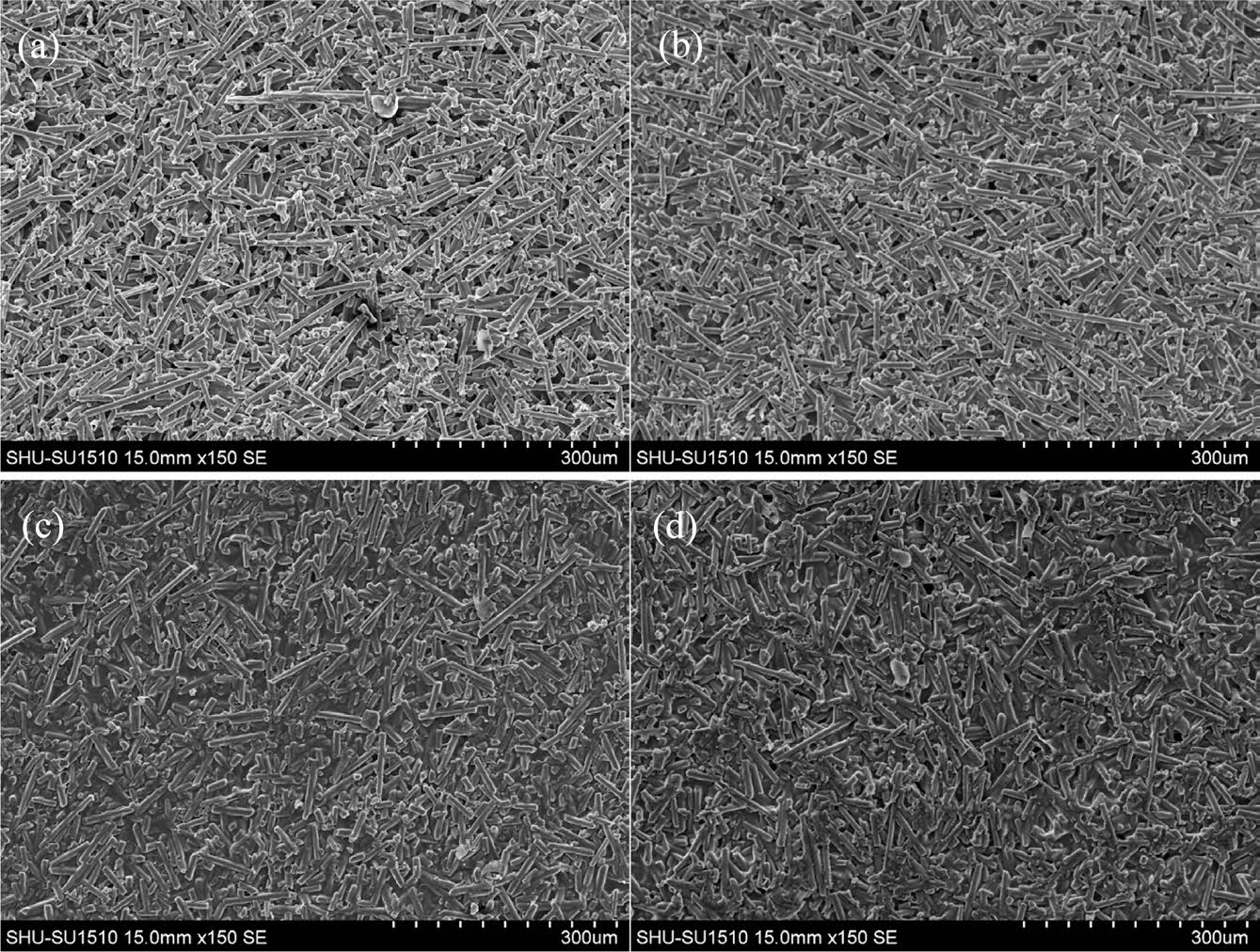
|
Figure 6 Scanning electron microscopy images for the internal conductive networks of (a) T2 sample; (b) T4 sample; (c) T6 sample; (d) T8 sample. |
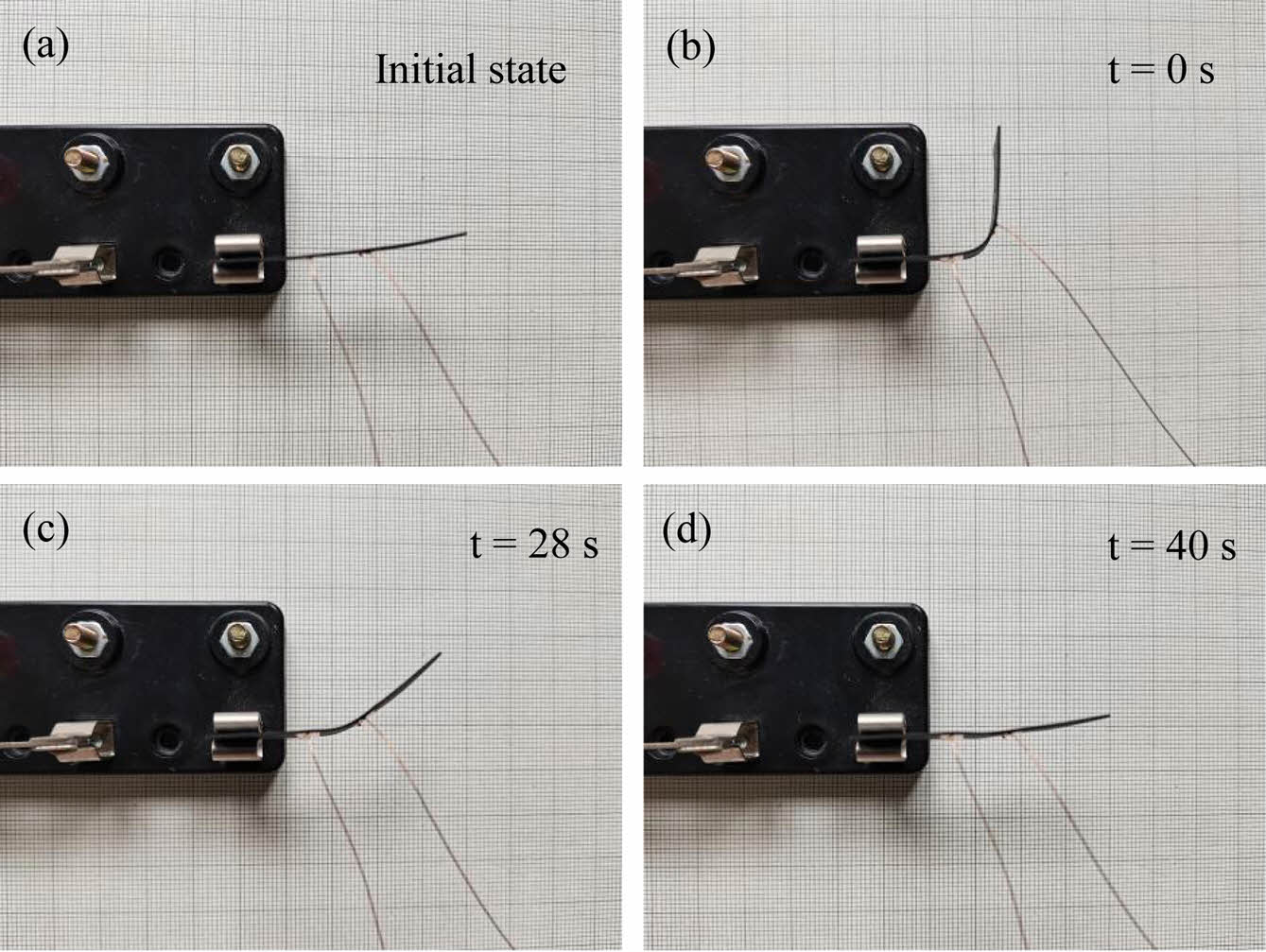
|
Figure 7 Shape memory progress of T4 sample: (a) initial state; (b) t = 0 s; (c) t = 28 s; (d) t = 40 s. |
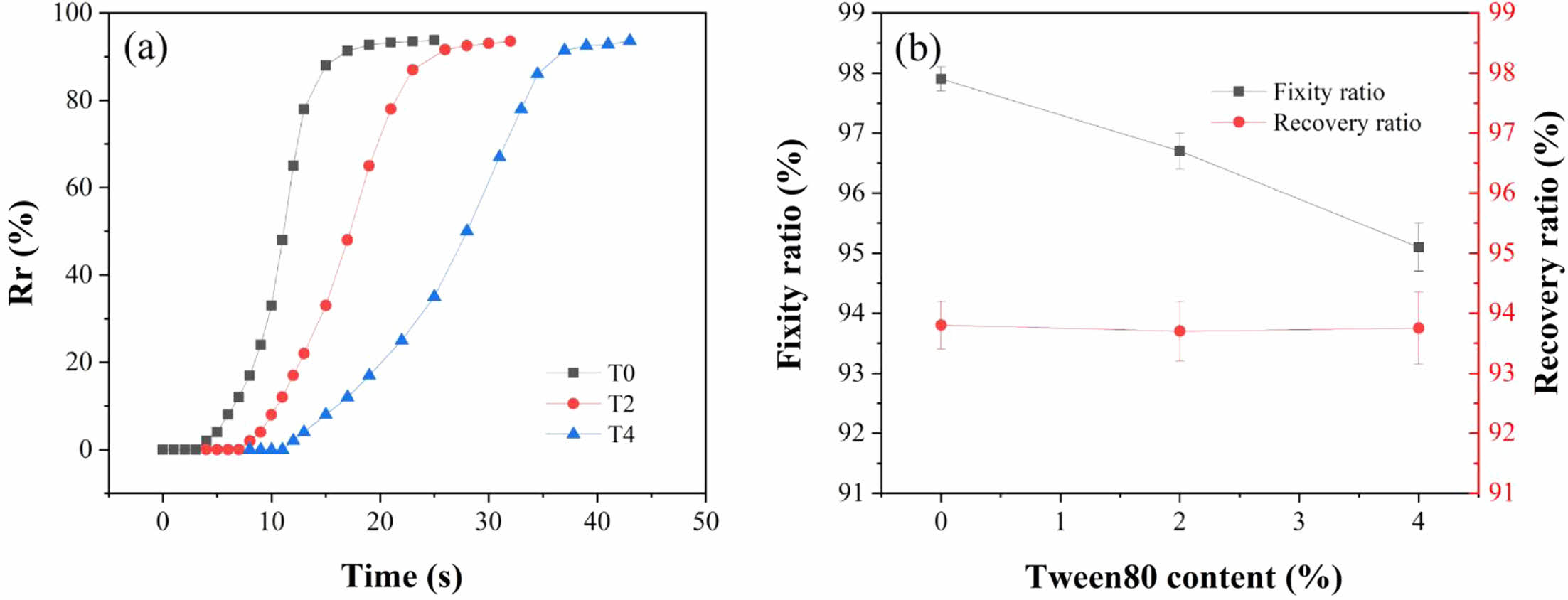
|
Figure 8 Shape memory behavior of the composites: (a) Shape recovery ratio versus time under 9 V voltages; (b) shape fixity ratios and shape recovery ratios. |
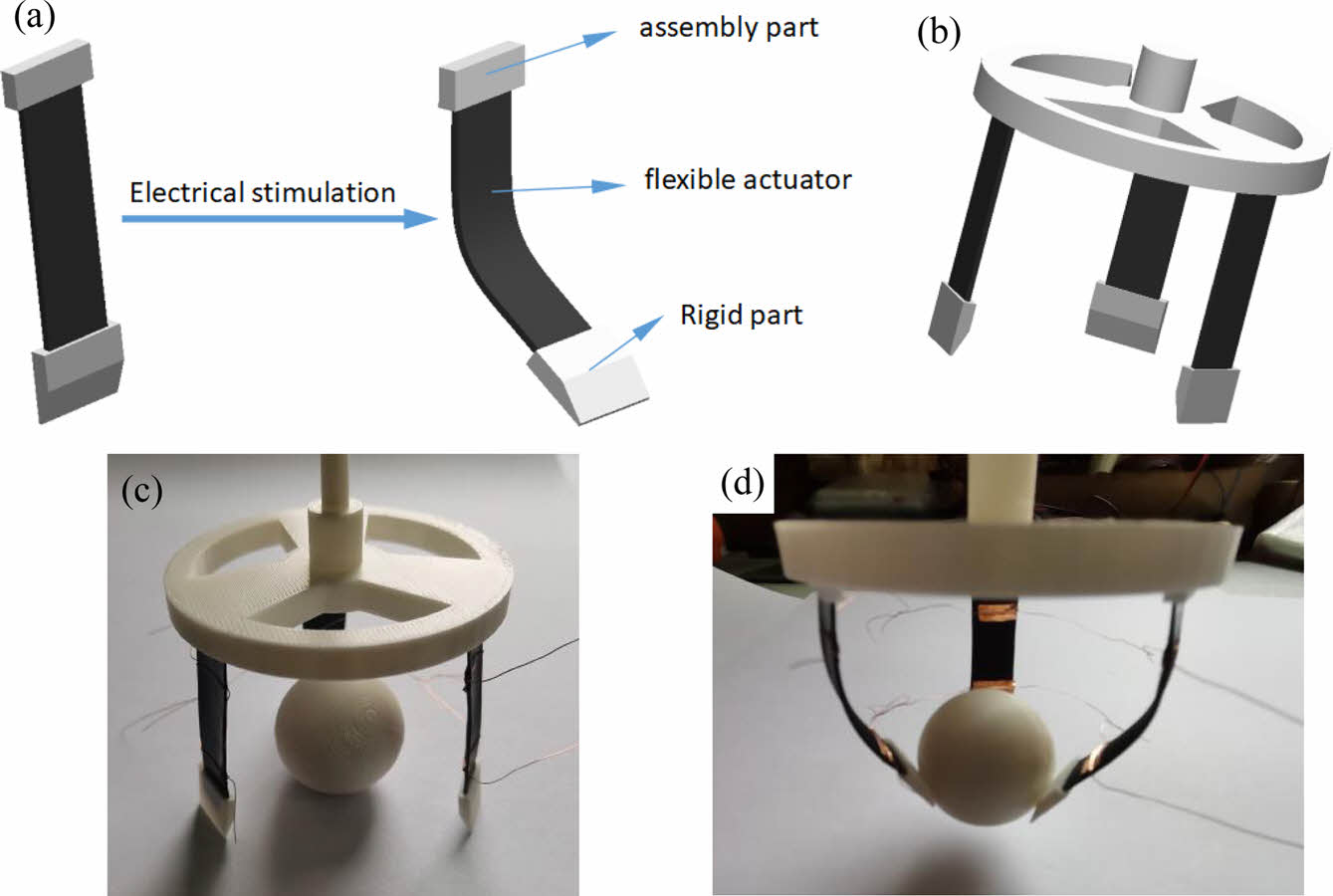
|
Figure 9 Structural design diagram and physical demonstration diagram of soft gripper: (a) electrical stimulation deformation of single self-folding structure; (b) schematic diagram of soft grabber; (c) the initial state of the soft gripper; (d) soft gripper in operation. |
In this paper, the properties of PVA/SCFs/Tween80 electroactive shape memory composites were studied through a series of experiments. The results showed that the electrical conductivity of the composite decreased with the addition of Tween80. When the Tween content was more than 6%, the decline trend of the electrical conductivity slowed down obviously. The deposition of SCFs in matrix was improved obviously by adding Tween80. When the addition of Tween80 was 4%, the tensile strength and Young's modulus of the composite were the best. The PVA/SCFs/Tween80 composite still showed good shape recovery properties under conductive conditions. Based on these results, adding the appropriate proportion of Tween80 had a positive effect on the mechanical properties of PVA/SCFs/Tween80 composites. A soft gripper based on three self-folding structure was designed, which successfully grabbed a ball with a mass of 14.5 g.
In conclusion, the PVA/SCFs/Tween80 composites have great potential in the field of soft grippers. The future work will further study the relationship between Tween80 content and other factors affecting the dispersion of the composite, and optimize the preparation process of the composite to further improve the mechanical properties.
- 1. Hu, J.; Zhu, Y.; Huang, H.; Lu, J. Recent Advances in Shape-memory Polymers: Structure, Mechanism, Functionality, Modeling and Applications. Prog. Polym. Sci. 2012, 37, 1720-1763.
-

- 2. Zhang, L.; Lin, Z.; Zhou, Q.; Ma, S.; Liang, Y.; Zhang, Z. PEEK Modified PLA Shape Memory Blends: Towards Enhanced Mechanical and Deformation Properties. Front. Mater. Sci. 2020, 14, 177-187.
-

- 3. Xia, L.; Wang, Q.; Meng, J.; Ma, Z.; Zhao, P. Thermal and Electro-induced Shape-memory Eucommia Ulmoides Gum Composites Filled with Carbon Nanotubes. Polym. Adv. Technol. 2021, 32, 3297-3308.
-

- 4. Dezaki, M. L.; Bodaghi, M. Soft Magneto-Responsive Shape Memory Foam Composite Actuators. Macromol. Mater. Eng. 2022, 307, 2200490.
-

- 5. Wang, Z.; Liu, J.; Yi, K.; Chen, P.; Zhu, Y.; Tian, D.; Chu, B. Shape Memory Effect and Light-induced Deformation in Schiff Base Molecular Crystals/PVDF Ferroelectric Polymer Composites. Chem. Eng. J. 2023, 455, 140693.
-

- 6. Song, Q.; Chen, H.; Zhou, S.; Zhao, K.; Wang, B.; Hu, P. Thermo- and pH-sensitive Shape Memory Polyurethane Containing Carboxyl Groups. Polym. Chem. 2016, 7, 1739-1746.
-

- 7. Zhang, Y.; Liu, T.; Lan, X.; Liu, Y.; Leng, J.; Liu, L. A Compliant Robotic Grip Structure Based on Shape Memory Polymer Composite. Compos. Commun. 2022, 36, 101383.
-

- 8. Zhang, F.; Xia, Y.; Liu, Y.; Leng, J. Nano/microstructures of Shape Memory Polymers: from Materials to Applications. Nanoscale Horiz. 2020, 5, 1155-1173.
-

- 9. Zare, M.; Davoodi, P.; Ramakrishna, S. Electrospun Shape Memory Polymer Micro-/Nanofibers and Tailoring Their Roles for Biomedical Applications. Nanomaterials 2021, 11, 933.
-

- 10. Lu, H.; Yu, K.; Sun, S.; Liu, Y.; Leng, J. Mechanical and Shape-memory Behavior of Shape-memory Polymer Composites with Hybrid Fillers. Polym. Int. 2010, 59, 766-771.
-

- 11. Chen, L.; Li, W.; Liu, Y.; Leng, J. Nanocomposites of Epoxy-based Shape Memory Polymer and Thermally Reduced Graphite Oxide: Mechanical, Thermal and Shape Memory Characterizations. Compos. B. Eng. 2016, 91, 75-82.
-

- 12. Xie, T. Recent Advances in Polymer Shape Memory. Polymer 2011, 52, 4985-5000.
-

- 13. Song, J. J.; Chang, H. H.; Naguib, H. E. Design and Characterization of Biocompatible Shape Memory Polymer (SMP) Blend Foams with a Dynamic Porous Structure. Polymer 2015, 56, 82-92.
-

- 14. Yao, Y.; Zhou, T.; Wang, J.; Li, Z.; Lu, H.; Liu, Y.; Leng, J. ‘Two Way’ Shape Memory Composites Based on Electroactive Polymer and Thermoplastic Membrane. Compos. Part A Appl. Sci. Manuf. 2016, 90, 502-509.
-

- 15. Hann, S. Y.; Cui, H.; Nowicki, M.; Zhang, L. G. 4D Printing Soft Robotics for Biomedical Applications. Addit. Manuf. 2020, 36, 101567.
-

- 16. Li, X.; Yang, Y.; Zhang, Y.; Wang, T.; Yang, Z.; Wang, Q.; Zhang, X. Dual-method Molding of 4D Shape Memory Polyimide Ink. Mater. Des. 2020, 191, 108606.
-

- 17. Wang, Y.; Li, X. 4D Printing Reversible Actuator with Strain Self-sensing Function via Structural Design. Compos. B. Eng. 2021, 211, 108644.
-

- 18. Ferreira, W. H.; Andrade, C. T. The Role of Graphene on Thermally Induced Shape Memory Properties of Poly(lactic acid) Extruded Composites. J. Therm. Anal. Calorim. 2021, 143, 3107-3115.
-

- 19. Erkmen, B.; Bayram, G. Improvement in Mechanical, Electrical, and Shape Memory Properties of the Polystyrene-based Carbon Fiber-reinforced Polymer Composites Containing Carbon Nanotubes. J. Appl. Polym. Sci. 2021, 138, e50541.
-

- 20. Kuang, T.; Zhang, M.; Chen, F.; Fei, Y.; Yang, J.; Zhong, M.; Wu, B.; Liu, T. Creating Poly(lactic acid)/carbon Nanotubes/carbon Black Nanocomposites with High Electrical Conductivity and Good Mechanical Properties by Constructing a Segregated Double Network with a Low Content of Hybrid Nanofiller. Adv. Compos. Hybrid Mater. 2023, 6, 48.
-

- 21. Ren, X.; Zhu, G. The Cooperative Effect of Short-cut Carbon Fiber and Carbon Black on the Performance of Electric-driven Morphing Skins. J. Reinf. Plast. Compos. 2022, 41, 851-860.
-

- 22. Wang, K.; Zhu, G.; Ren, F.; Yan, X.; Cui, X. The Effects of Carbon Fiber on Electroactive Shape Memory Behaviors of Cyanate/polybutadiene Epoxy/carbon Black Composites. J. Reinf. Plast. Compos. 2016, 35, 556-565.
-

- 23. Lin, L.; Zhou, Q.; Li, M. Thermal and Electroactive Shape Memory Behaviors of Polyvinyl alcohol/Short Carbon Fiber Composites. Polym. Sci. Ser. A 2020, 61, 913-921.
-

- 24. Li, Y.; Huang, X.; Zeng, L.; Li, R.; Tian, H.; Fu, X.; Wang, Y.; Zhong, W. H. A Review of the Electrical and Mechanical Properties of Carbon Nanofiller-reinforced Polymer Composites. J. Mater. Sci. 2019, 54, 1036-1076.
-

- 25. Guadagno, L.; Raimondo, M.; Vittoria, V.; Vertuccio, L.; Lafdi, K.; De Vivo, B.; Lamberti, P.; Spinelli, G.; Tucci, V. The Role of Carbon Nanofiber Defects on the Electrical and Mechanical Properties of CNF-based Resins. Nanotechnology 2013, 24, 305704.
-

- 26. Nie, Y.; Hubert, T. Effect of Carbon Nanofiber (CNF) Silanization on the Properties of CNF/epoxy Nanocomposites. Polym. Int. 2011, 60, 1574-1580.
-

- 27. Kato, H.; Mizuno, K.; Shimada, M.; Nakamura, A.; Takahashi, K.; Hata, K.; Kinugasa, S. Observations of Bound Tween80 Surfactant Molecules on Single-walled Carbon Nanotubes in An Aqueous Solution. Carbon 2009, 47, 3434-3440.
-

- 28. Arronche, L.; La Saponara, V.; Yesil, S.; Bayram, G. Impact Damage Sensing of Multiscale Composites Through Epoxy Matrix Containing Carbon Nanotubes. J. Appl. Polym. Sci. 2013, 128, 2797-2806.
-

- 29. da Casta, D. M.; Cunha, V. R. R.; Perotti, G. F.; Henriques, R. R.; Amim, J.; Shiguihara, A. L. Effect of Nonionic Surfactants on the Crystallinity and Thermal Stability of Poly(vinyl alcohol) Film. Orbital Electron. J. Chem. 2020, 14, 213-219.
-

- 30. Babaie, A.; Rezaei, M.; Roghani-Mamaqani, H. Tuning Microphase Separation, Thermal Characteristics, and Physicomechanical Properties of Shape Memory Polyurethanes by Incorporation of Isocyanate-Modified Fe3O4 Magnetic Nanoparticles. Macromol. Mater. Eng. 2022, 307, 2100637.
-

- 31. Shintake, J.; Cacucciolo, V.; Floreano, D.; Shea, H. Soft Robotic Grippers. Adv. Mater. 2018, 30, 1707035.
-

- Polymer(Korea) 폴리머
- Frequency : Bimonthly(odd)
ISSN 0379-153X(Print)
ISSN 2234-8077(Online)
Abbr. Polym. Korea - 2022 Impact Factor : 0.4
- Indexed in SCIE
 This Article
This Article
-
2023; 47(5): 598-605
Published online Sep 25, 2023
- 10.7317/pk.2023.47.5.598
- Received on Apr 23, 2023
- Revised on Jul 14, 2023
- Accepted on Jul 24, 2023
 Services
Services
- Full Text PDF
- Abstract
- ToC
- Acknowledgements
- Conflict of Interest
Introduction
Experimental
Results and Discussion
Conclusions
- References
Shared
 Correspondence to
Correspondence to
- Liulan Lin
-
*Shanghai Key Laboratory of Smart Manufacturing and Robotics, Shanghai University, Shanghai 200444, China
**National Demonstration Center for Experimental Engineering Training Education, Shanghai University, Shanghai 200444, China - E-mail: linliulan@staff.shu.edu.cn
- ORCID:
0000-0002-8212-5004









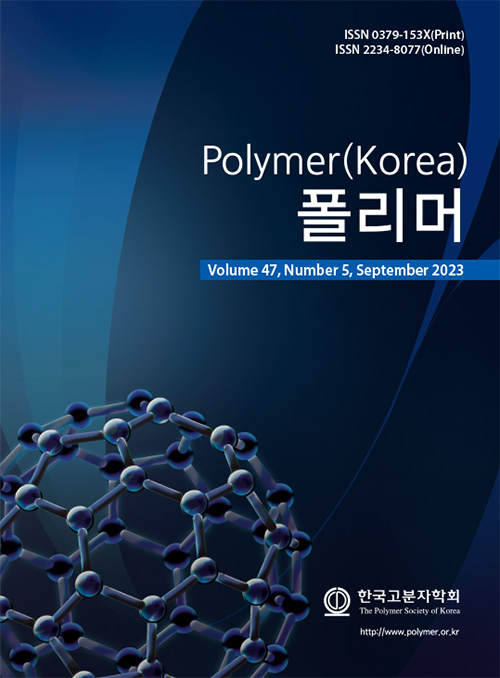
 Copyright(c) The Polymer Society of Korea. All right reserved.
Copyright(c) The Polymer Society of Korea. All right reserved.